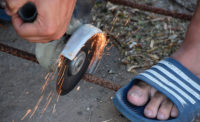Everyone at the plant was overwhelmed by this incident and by the death of their fellow employee and friend. Corporate office personnel scrambled to investigate. How could this — which was an actual event — have happened?
The manufacturing leader, responsible for safety at this company’s plants, traveled to all facilities and interviewed warehouse and shipping workers. He heard over 100 “near-hit†stories, all very similar but with different outcomes. Only luck had prevented a devastating incident and death, like the one described above, from happening before. All these plants are now heavily protected from this type of occurrence. If only near-hits had been reported and acted upon, this death could most likely have been avoided.
What is a near-hit? Some would call it a “close call,†a “near miss,†an “oops!,†a “thank God.†A near-hit is an unplanned event that has a high probability of injury or property loss.
The search for proactive methods of providing a safe working environment has increased in the past few years. What better way is there to prevent incidents than by looking at events that just missed being an incident? Collecting near-hits, determining causes, correcting and communicating them could help reduce incidents and injury rates.
What stymies reporting?
So why isn’t near-hit reporting more prevalent in industry? One reason is fear of reprisal and embarrassment. The perceived organizational message may not be positive towards near-hits, treating the incident as a mistake and not as an opportunity to take proactive steps to prevent injuries and promote safety. A near-hit can be very personal. Often an employee is relieved to be okay and doesn’t want to think about what could have happened.In addition, and very important, if near-hit incident reports are collected and the information is not evaluated and disseminated and no action taken, workers will become discouraged and stop sharing. A near-hit form may be inconvenient to fill out, not readily available, or there may be no time allotted to complete it. But, again, near-hits provide an excellent opportunity to learn proactively from what some consider free lessons or just old-fashioned good luck.
In working with manufacturing concerns, my company actively encourages all workers to voluntarily and anonymously submit near-hit reports in their words. Normally, very few decline to do so. At any given facility, we receive hundreds of near-hits that we collate, discuss with employees and make a final analysis. These reports come from all employees, including management, supervisors and hourly workers. Invariably, it is fairly easy to predict the greatest potentials for injuries in that facility. This is especially true when combined with procedural, compliance and behavioral observations with all involved on a daily basis.
However, this process must be built using a positive approach with a goal of creating a safe culture where employees feel comfortable sharing not only safe behaviors (practices), but also unsafe behaviors (practices). This works in concert with safety rules and disciplinary actions being in place. I call it a “process†because it must be done on a continuous and consistent basis.
SHARING principles
Steps to successful integration and acceptance of near-hit reporting can be summed up in a word, “SHARINGâ€:
If a facility is part of a larger corporation, intra-company sharing is strongly encouraged. “Best practices sharing†is an initiative that has been growing stronger in recent years. Who can argue against sharing safety best practices?
Inviting employees’ families to participate can be also very effective. A Plant Safety Activity Day, including families in attendance, is one way of accomplishing this.
Building trust
In the words of a great teacher/philosopher: Tell me and I will forget…Show me and I will remember… Involve me and I will understand. And adding our words: Recognize me and I will do it again and again.Trust is a building process. Positively reinforced participation will provide a foundation to build a sound structure (culture) of sharing.
You don’t need to wait for a serious injury, incident or death in order to analyze what changes need to be made in working conditions or safety practices. Rather, use an incident or near-hit as an opportunity to find and eliminate causes of problems that could result in serious injuries, death or property damage.
It can never be over-emphasized: Employees are a company’s greatest asset and resource. To achieve safety success, do whatever you can to encourage them to share their experiences, knowledge of their jobs and recommendations.
SIDEBAR: It’s a good thing…
One of the keys to successfully integrating near-hit reporting into your safety culture is positive reinforcement. By making near-hit reporting a positive experience for your employees, they will more readily participate in the activity.Plant-wide celebrations that recognize: 1) employees’ participation in near-hit reporting, and 2) achieved solutions to the causes of the near-hits, will go a long way toward building trust and active participation by all.
